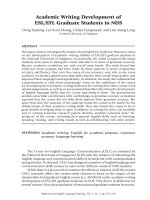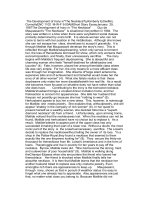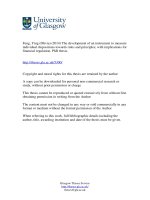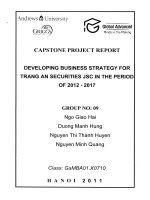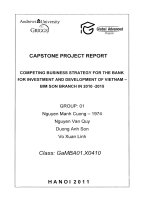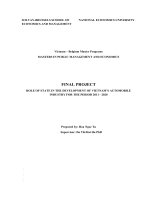Development of an encapsulation technique in control of pathogen
Bạn đang xem bản rút gọn của tài liệu. Xem và tải ngay bản đầy đủ của tài liệu tại đây (1.9 MB, 107 trang )
DEVELOPMENT OF AN ENCAPSULATION TECHNIQUE
IN CONTROL OF PATHOGEN
MOU HONGHUI
NATIONAL UNIVERSITY OF SINGAPORE
2005
DEVELOPMENT OF AN ENCAPSULATION TECHNIQUE
IN CONTROL OF PATHOGEN
MOU HONGHUI
(B.Eng (Hons). NUS)
A THESIS SUBMITTED
FOR THE DEGREE OF MASTER OF ENGINEERING
DEPARTMENT OF CHEMICAL AND BIOMOLECULAR ENGINEERING
NATIONAL UNIVERSITY OF SINGAPORE
2005
ACKOWNLEDGEMENTS
Firstly, I would like to take this opportunity to thank my supervisors, Dr. J. Paul Chen
and Prof. Jimmy Kwang, for their extensive support, guidance and encouragement
throughout the course of this thesis.
I would also like to thank Ms. Du Qingyun, Mr. Kit Wai and others in Prof Kwang’s
laboratory for helpful advice during the work. I would like to thank Ms. Nitar for
providing the partially purified HA and invaluable suggestions. I would like to
acknowledge the help of several final year students, Mr. Benjamin Wong Choon Kiat, Mr.
Tang Zhan Sheng, and Miss Toh Shi Ling in the Department of Chemical &
Biomolecular Engineering for their help at different times and thank them for the same. I
would like to extend my gratitude to Madam Susan Chia and Madam Li Xiang in the
Department of Chemical & Biomolecular Engineering for help with equipment and
various odds and ends. I also thank my colleagues in Dr Chen’s laboratory, Mr. Zou
Shuaiwen and Mr. Yang Lei for their support and help.
Last but not least, I would like to thank the Department of Chemical & Biomolecular
Engineering for the financial and logistic support.
i
TABLE OF CONTENTS
ACKNOWLEDGEMENTS
i
TABLE OF CONTENTS
ii
SUMMARY
v
NOMENCLATURE
vii
ABBREVIATIONS
ix
LIST OF FIGURES
x
LIST OF TABLES
xii
CHAPTER 1 INTRODUCTION
1
1.1 Motivation and objectives
1
1.2 Organization of the thesis
3
CHAPTER 2 BACKGROUND AND LITERATURE REVIEW
2.1 Influenza and H5N1 virus
4
4
2.1.1 Influenza and its virus
4
2.1.2 Influenza pandemic and its impact
7
2.1.3 Avian influenza (Bird flu) and H5N1 virus
9
2.1.4 Prevention and treatment
10
2.2 Vaccination through a delivery system
11
2.3 Common microencapsulation techniques
13
2.3.1 Solvent evaporation/extraction
13
2.3.2 Phase separation
15
2.3.3 Spray drying
16
2.3.4 Extrusion
16
ii
2.4 Electrostatic extrusion
20
2.4.1 Droplet formation under electrostatic potential
21
2.4.2 Modes of electrostatic dispersion
26
2.4.3 Governing factors on microcapsule formation
29
2.5 Alginate as a vaccine delivery system
30
2.5.1 Alginate
31
2.5.2 Ca-alginate matrix
33
2.5.3 Chitosan
34
2.5.4 Alginate-chitosan matrix
35
CHAPTER 3 MATERIALS AND METHODOLOGY
3.1 Materials
37
37
3.1.1 List of chemicals
37
3.1.2 Stock preparation
38
3.2 Experimental setup
39
3.2.1 Equipments and accessories
39
3.2.2 System configurations
39
3.3 Experimental procedures
41
3.3.1 Microcapsule formation
41
3.3.2 Antigen release
42
3.4 Determination of microcapsule properties
44
3.4.1 Particle size
44
3.4.2 Microcapsule morphology
45
3.4.3 BSA release
45
3.4.4 HA release
46
iii
CHAPTER 4 RESULTS AND DISCUSSION
4.1 Optimum conditions for antigen encapsulation
47
47
4.1.1 Effect of applied voltage
49
4.1.2 Effect of flow rate
54
4.1.3 Effect of electrode spacing
58
4.1.4 Effect of needle size
61
4.2 Microcapsule morphology
63
4.2.1 Effect of pH on microcapsule surface
65
4.2.2 Effect of chitosan coating on microcapsule surface
66
4.3 Antigen release
68
4.3.1 BSA release from alginate matrices
69
4.3.2 HA release from alginate matrices
76
CHAPTER 5 CONCLUSIONS AND RECOMMENDATIONS
79
5.1 Conclusions
79
5.2 Recommendations for future work
80
REFERENCES
82
iv
SUMMARY
The transmission of avian H5N1 influenza viruses to 18 humans in Hong Kong in
1997 with six deaths established that avian influenza viruses can transmit to and cause
lethal infection in humans. Concerns were raised about another global influenza
pandemic because humans have absolutely no immunity against any H5 viruses. At
present, vaccination remains the principal measure for preventing influenza and
reducing the impact of epidemics. In this study, I investigated the use of
microencapsulation in alginate matrix for antigen delivery.
Bovine serum albumin (BSA) and partial purified hemagglutinin (HA) proteins were
encapsulated in alginate matrix by electrostatic extrusion technique to form a delivery
system which allowed for controlled release of protein. A positively charged needle
with grounded collecting solution system was selected as the electrode configuration
for the extrusion process. I found that applied voltage, flow rate, electrode spacing and
needle size played their roles in electrostatic microcapsule formation and models were
established between microcapsule size and two dominant factors, i.e., applied voltage
and flow rate. As the voltage applied to the needle was increased, the formed droplets
were reduced in size. However, any increase in applied voltage above its critical point
did not result in much reduction in droplet size. Further reduction in droplet size
would be achieved by reducing the flow rate of the polymer solution, which would
give more time for counter ions to diffuse to droplet surface and reduce the surface
tension. Meanwhile, either narrowing the electrode spacing or decreasing the needle
size could also help reduce droplet size.
v
Alginate, a natural polysaccharide, was selected to form the polymeric matrix for
antigen encapsulation, due to its excellent biocompatibility, biodegradability and nontoxicity. Alginate can be ionically crosslinked by the addition of divalent cations, such
as Ca2+, Sr2+, and Ba2+, in aqueous solution. However, the resulting Ca-alginate
microcapsules are very porous. My study showed a quick release of BSA proteins in
Tris-HCl buffer solution. Therefore, polymeric coatings are often applied to ensure
better isolation and retention of the encapsulated material. Poly-L-lysine and chitosan
are the most commonly used polycations for microcapsule production. My study
favoured chitosan over poly-L-lysine due to its low cost, easy access and naturalness.
In vitro results showed protein release was affected by microcapsules size, pH, protein
loading, and release medium. It would be significantly delayed if chitosan coating
were applied on the Ca-alginate microcapsules. Further investigations were needed to
explore the in vivo function of alginate matrix, strengthen alginate matrix by Ba2+,
improve antigen loading efficiency and scale up the microcapsule production.
vi
Nomenclature
Symbol
Description
d
diameter of the droplet, m
do
diameter of the droplet under gravity only, m
db
diameter of the gel beads in the receiving solutions, m
dc
internal diameter of the needle, m
de
external diameter of the needle, m
ds
diameter of the pendant droplet neck, m
D
diffusion coefficient of the surfactant, m2/s
Δx
characteristic diffusional length, m
εo
permittivity of the vacuum (air), F/m
F
Faraday constant, C/mol
Fe
electric force under applied electrical potential, N
g
gravity constant, N/kg
γ
liquid surface tension, N/m
γo
liquid surface tension (under gravity only or pure water), N/m
γe
surface tension at its equilibrium value, N/m
Γ
adsorption amount of a surfactant at the droplet surface, mol/m2
h
distance between the droplet and collecting solution, m
js
flux of the surfactant into the surface, mol/m2⋅s
jv
flow rate of the solution, m3/s
k
fitting parameter
K
electrical conductivity, (S/m)
vii
μ
viscosity of the solution, Pa⋅s
qo
electrical charge accumulated, C
ρd
density of the dispersed phase, kg/m3
τad
characteristic relaxation time of the adsorption, s
τv
characteristic relaxation time of the formation of the drop, s
U
applied electrical potential, V
Ucr
electrostatic potential at critical point, V
viii
Abbreviations
BCA
Bicinchoninic acid
BSA
Bovine serum albumin
CDC
Centers for Disease Control and Prevention
DNA
Deoxyribonucleic acid
FITC-BSA
Bovine serum albumin-fluorescein isothiocyanate
H5N1
Hemagglutinin type 5 & Neuraminidase type 1
HA
Hemagglutinin
HPAI
Highly pathogenic avian influenza
M1
Matrix protein 1
M2
Matrix protein 2
NA
Neuraminidase
NP
Nucleoprotein
PLG
Polylactide-co-glycolides
RNA
Ribonucleic acid
vRNA
viral RNA
mRNA
messenger RNA
RNP
Ribonucleoprotein
SDS-PAGE
Sodium dodecyl sulfate - polyacrylamide gel electrophoresis
SEM
Scanning electron microscope
WHO
World Health Organization
W/O/W
Water-in-oil-in-water
ix
List of Figures
Figure 2.1
Microscopy image of influenza virus
4
Figure 2.2
A schematic drawing of influenza virus structure
6
Figure 2.3
Replication cycle of influenza virus
7
Figure 2.4
Double emulsion technique for microencapsulation
13
Figure 2.5
Extrusion devices
17
Figure 2.6
Droplet formation under simple gravity
21
Figure 2.7
Effect of electric field on the droplet formation
22
Figure 2.8
Effect of kinetic factors on droplet formation
24
Figure 2.9
Structure of alginate
31
Figure 2.10
“Egg-box” junction of Ca-alginate matrix
33
Figure 2.11
Structure of chitosan
34
Figure 3.1
Pictures of equipments and accessories
40
Figure 3.2
System configurations of electrostatic extrusion process
40
Figure 4.1
A typical result from the particle size analyzer
47
Figure 4.2
Satellite formation under an electrical potential
48
Figure 4.3
Effect of applied voltage on microcapsule formation
50
Figure 4.4
Transition from dripping mode to cone-jet mode
51
Figure 4.5
Stable and unstable jet emission from the needle
52
Figure 4.6
Linear models for microcapsule size estimation
53
Figure 4.7
Effect of flow rate on microcapsule formation
55
Figure 4.8
Scaling laws for 1% Na-alginate solution
57
x
Figure 4.9
Modified scaling laws for 1% Na-alginate solution
58
Figure 4.10
Effect of electrode spacing on microcapsule formation
60
Figure 4.11
Effect of needle size on microcapsule formation
62
Figure 4.12
Ca-alginate microcapsule surface
64
Figure 4.13
pH effects on microcapsule surface structure
65
Figure 4.14
Ca-alginate microcapsule surface (No coating Vs. Coating)
66
Figure 4.15
SEM pictures of microcapsules with different coatings
67
Figure 4.16
SEM picture of freeze-dried Ca-alginate–chitosan microcapsule
68
Figure 4.17
The release of BSA from alginate matrix
70
Figure 4.18
Effect of microcapsule size on BSA release
70
Figure 4.19
Effect of pH on BSA release
71
Figure 4.20
Effect of BSA loading on BSA release
72
Figure 4.21
Effect of coating time of chitosan on BSA release
73
Figure 4.22
Effect of release medium on BSA release
74
Figure 4.23
BSA encapsulation efficiency and release conditions
75
Figure 4.24
HA release from alginate matrix in Tris-HCl buffer
77
Figure 4.25
Effect of chitosan coating on HA release
77
Figure 4.26
SDS-PAGE results of HA release
78
Figure 4.27
Western blotting results of HA release
78
xi
List of Tables
Table 2.1
Differences between influenza A, B, and C viruses
5
Table 2.2
Methods in droplet extrusion
17
Table 2.3
Characteristic features of the modes of electrostatic dispersion
27
Table 2.4
General properties of chitosan
35
Table 4.1
Control parameters for microencapsulation experiments
48
Table 4.2
Effect of applied voltage on microcapsule formation
49
Table 4.3
Effect of flow rate on microcapsule formation
54
Table 4.4
Physical properties of 1% Na-alginate solution
56
Table 4.5
Effect of electrode spacing on microcapsule formation
59
Table 4.6
Effect of needle size on microcapsule formation
61
Table 4.7
Factors in the control of microcapsule permeability
69
xii
Chapter 1
CHAPTER 1
1.1
INTRODUCTION
Motivation and objectives
In 1997, an influenza virus (H5N1) known to infect only birds previously was found to
infect human causing disease and death in Hong Kong and the outbreak involved 18
patients with six deaths (Tam, 2002). The government of Hong Kong decided on 28
December 1997, to cull all chickens in Hong Kong and 1.5 million of birds were killed
from 29 to 31 December 1997. Since then, an epidemic of influenza in poultry,
commonly referred to as “bird flu”, began sweeping through several countries in the
Pacific Rim (Vietnam, Thailand, Japan, China, South Korea, Cambodia) in early 21st
century. It caused serious financial damage, public health threat and mental distress to
people in the region. Scientists also warned its potential to develop into another deadly
global pandemic. World Health Organization (WHO) has urged both developed and
developing countries to act swiftly and decisively to control and contain this outbreak.
The most powerful thrust to the influenza control program focuses on vaccination
(Straus, 1993). To curb spread of “bird flu”, Vietnam government plans to test
vaccines in chickens and ducks from June to August 2005, leading to compulsory
vaccination in high-risk areas in October. Ho Chi Minh City will conduct trial
vaccination with 600,000 doses of Trovac avian influenza vaccine, produced by
Merial France, while 2.7 million doses of a related Dutch vaccine will be tested
elsewhere in the country, according to the official Vietnam News Agency.
Most influenza vaccines are prepared from influenza virus strains grown in
embryonated hens’ eggs. However, reactions are reported in some vaccinees given
1
Chapter 1
whole, inactive virus vaccine; thus many contemporary vaccines are vaccines
containing only the surface hemagglutinin (HA) and neuraminidase (NA)
glycoproteins, termed subunit vaccines (Potter, 1994). However, subunit antigens
alone are usually only weak immunogens and require an adjuvant or carrier system to
induce protective immunity. The quality of the resulting antibody-and/or cell-mediated
immune response and its magnitude depends on appropriate antigen processing and
the cytokine profile generated by the combined action of the antigen and the adjuvant
(Felnerova et al., 2004).
Many vaccine delivery systems have been proposed to provide sustained release
and/or to increase the immune response. One approach to the development of delivery
system for vaccines involves the use of polymer encapsulation of antigens (Singh and
O’Hagan, 1998). The polymeric microcapsules that protect antigen from acidic and
enzymatic degradation in the gastrointestinal tract also provide a stable vaccine
vehicle with extended shelf life. Once encapsulated, antigen is released from the
microspheres by diffusion through matrix pores and by matrix degradation (Morris et
al., 1994).
A number of different polymers have been evaluated for the development of oral
vaccines, including naturally occurring polymers (e.g. starch, alginates and gelatin)
and synthetic polymers (e.g. polylactide-co-glycolides (PLG), polyanhydrides and
phthalates). In material selection, of primary concern are considerations of toxicity,
irritancy and allergenicity, and the need for a biodegradable or a soluble coating.
Usually, natural polymers are preferred. The advantages of using natural polymers
include their low cost, biocompatibility and aqueous solubility (Singh and O’Hagan,
2
Chapter 1
1998). Among all the natural polymers, alginate is the most commonly employed
polymer for cell encapsulation (Gerbsch and Buchholz, 1995). Many studies have also
been carried out using alginate matrix as a vaccine delivery system (Kwok et al., 1989;
Bowersock et al., 1994 and 1996; Wee et al., 1995). The main advantages of using
alginate microcapsules for antigen delivery are the low cost of polymer, good
biocompatibility and ease of preparation (Singh and O’Hagan, 1998).
In my study, Bovine serum albumin (BSA) and partial purified hemagglutinin (HA)
proteins were encapsulated in alginate matrix by electrostatic extrusion technique to
form a delivery system which allowed for controlled release. The objectives of this
study were:
— Encapsulate antigens (BSA or HA) in alginate matrix by electrostatic extrusion
— Study the governing factors of electrostatic extrusion process
— Study the in vitro release of BSA or HA from Ca-alginate matrix
— Study the effect of chitosan coating on the microcapsule structure and antigen
release
1.2
Organization of the thesis
This thesis is divided into five chapters. Chapter 1 is an introduction to the motivation
and objectives of the project, followed by a description of the organization of the
thesis. Chapter 2 is a literature review on the influenza A H5N1 virus, vaccination,
microencapsulation by electrostatic extrusion and formation of alginate matrix. In
Chapters 3, materials and methods used in this study are described. The experimental
results as well as the discussion are presented in Chapter 4. Finally, a summary of the
findings in this study and recommendations for future research are given in Chapter 5.
3
Chapter 2
CHAPTER 2
BACKGROUND AND LITERATURE REVIEW
2.1
Influenza and H5N1 virus
2.1.1
Influenza and its virus
According to World Health Organization (WHO, 2003), influenza is caused by a virus
that attacks mainly the upper respiratory tract – the nose, throat and bronchi and rarely
also the lungs. The infection usually lasts for about a week. It is characterized by
sudden onset of high fever, myalgia, headache and severe malaise, non-productive
cough, sore throat, and rhinitis. Most people recover within one to two weeks without
requiring any medical treatment. In the very young, the elderly and people suffering
from medical conditions such as lung diseases, diabetes, cancer, kidney or heart
problems, influenza poses a serious risk. In these people, the infection may lead to
severe complications of underlying diseases, pneumonia and death.
Influenza viruses (Fig. 2.1) belong to the family Orthomyxoviridae and are separated
into types A, B and C according to antigenic differences in their respective
nucleocapsid (WHO, 2002).
Figure 2.1
Microscopy image of influenza virus (Stannard, 1995)
4
Chapter 2
There are significant differences in genetic organization, structure, host range,
epidemiology, and clinical characteristics between the three influenza virus types,
which are summarized in Table 2.1.
Table 2.1
Differences between influenza A, B, and C viruses (Treanor, 1999)
Influenza A
Influenza B
Influenza C
Genetics
8 gene segments
8 gene segments
7 gene segments
Structure
10 viral proteins
11 viral proteins
9 viral proteins
M2 protein unique
NB protein unique
HEF protein unique
Host range
Humans, swine,
equine, avian,
marine mammals
Humans only
Humans and swine
Epidemiology
Antigenic shift and
drift; Drift is
generally linear
Antigenic drift
Antigenic drift
only; More than
only; Multiple
one variant may co- variants
circulate
Clinical features
May cause large
pandemics with
significant
mortality in young
disease
Severe disease
generally confined
to elderly or those
at high risk;
pandemics not seen
Mild disease
without seasonality
As shown in Fig. 2.2, influenza viruses are negative-strand RNA viruses with a
segmented genome. The eight RNA segments of influenza viruses (seven for influenza
C) are independently encapsulated by the viral nucleoprotein (NP) and each segment
is associated with a polymerase complex. The subviral particle consisting of viral
RNA (vRNA), NP and polymerase complex is called ribonucleoprotein (RNP) particle.
The RNP particles are located inside a shell of M1 protein which lines with the viral
lipid membrane. The surface of the particle contains three kinds of spike proteins:
hemagglutinin (HA), neuraminidase (NA), and matrix protein (M2, only on type A).
5
Chapter 2
Hemagglutinin (HA)
Neuraminidase (NA)
Lipid membrane
Matrix Protein
(M1)
M2 Protein
(only on type A)
Ribonucleoprotein (RNP):
- vRNA
- Polymerase
- Nucleoprotein
Figure 2.2
A schematic drawing of influenza virus structure
Further classification of type A virus into subtype is dependent on differences in the
HA and NA antigens, and 16 HA and 9 NA subtypes are known so far. Influenza A
viruses are distinguished according to a formula, such as A/Hong Kong/1/68 (H3N2):
this designation means that the virus is type A, was isolated in Hong Kong, is the first
laboratory isolate made in 1968, and has the HA and NA molecule forms HA3 and
NA2, respectively (Potter, 1994).
The influenza virus replicates by entering a host cell and using this cell's resources to
produce hundreds of copies of the viral RNA (Fig. 2.3). The virus attaches to the
outside of the host cell and its RNA enters into the cell. Fusion and uncoating events,
which are pH dependent, result in the release of the viral genomes into the cytoplasm.
They are then imported into the nucleus for replication. Positive-sense viral messenger
RNAs (mRNAs) are exported out of the nucleus into the cytoplasm for protein
6
Chapter 2
synthesis. Some of the proteins are imported into the nucleus to assist in viral RNA
replication and packaging. In this way, the virus takes over the cell's productivity.
Now, instead of producing only new cellular material, the cell produces hundreds of
new virus particles. Those particles are eventually released from the cell and drift off.
Figure 2.3
2.1.2
Replication cycle of influenza virus (Levine, 1992)
Influenza pandemic and its impact
Influenza viruses can change in two different ways.
— Antigenic drift, the HA and NA proteins of the influenza virus can undergo minor
changes or mutations, leading to new strains. It happens continually over time, and
7
Chapter 2
produces new virus strains that may not be recognized by antibodies to earlier
influenza strains.
— Antigenic shift, it is an abrupt, major change in the influenza A viruses, resulting in
a new influenza virus that can infect humans and has a new HA or HA and NA
protein combination that has not been seen in humans for many years.
Antigenic shift results in a new influenza A subtype. If a new subtype of influenza A
virus is introduced into the human population, if most people have little or no
protection against the new virus, and if the virus can spread easily from person to
person, a pandemic may occur.
According to WHO (2003), three times in the last century, the influenza A viruses
have undergone major genetic changes mainly in their H-component, resulting in
global pandemics and large tolls in terms of both disease and deaths. The most
infamous pandemic was “Spanish Flu” which affected large parts of the world
population and is thought to have killed at least 40 million people in 1918-1919. More
recently, two other influenza A pandemics occurred in 1957 (“Asian influenza”) and
1968 (“Hong Kong influenza”) and caused significant morbidity and mortality
globally. Most recently, limited outbreaks of a new influenza subtype A (H5N1)
directly transmitted from birds to humans have occurred in Hong Kong Special
Administrative Region of China in 1997 and 2003.
According to Centers for Disease Control and Prevention (CDC), many scientists
believe it is only a matter of time until the next influenza pandemic occurs (U.S. CDC,
2005a). The severity of the next pandemic cannot be predicted, but modeling studies
8
Chapter 2
suggest that its effect in the United States could be severe. In the absence of any
control measures (vaccination or drugs), it has been estimated that in the United States
a “medium–level” pandemic could cause 89,000 to 207,000 deaths, between 314,000
and 734,000 hospitalizations, 18 to 42 million outpatient visits, and another 20 to 47
million people being sick. Between 15% and 35% of the U.S. population could be
affected by an influenza pandemic, and the economic impact could range between
$71.3 and $166.5 billion.
2.1.3
Avian influenza (Bird flu) and H5N1 virus
Avian influenza (Bird flu) is an infection caused by avian influenza viruses. These flu
viruses occur naturally among birds (U.S. CDC, 2005b). All birds are thought to be
susceptible to infection with avian influenza, though some species are more resistant
to infection than others. Infection causes a wide spectrum of symptoms in birds,
ranging from mild illness to a highly contagious and rapidly fatal disease resulting in
severe epidemics. The latter is known as “highly pathogenic avian influenza” (HPAI).
This form is characterized by sudden onset, severe illness, and rapid death, with a
mortality that can approach 100%.
According to WHO (2004), fifteen subtypes of influenza virus are known to infect
birds, thus providing an extensive reservoir of influenza viruses potentially circulating
in bird populations. Of the 15 avian influenza virus subtypes, H5N1 is of particular
concern for several reasons. H5N1 mutates rapidly and has a documented propensity
to acquire genes from viruses infecting other animal species. Its ability to cause severe
disease in humans has now been documented on several occasions. In addition,
laboratory studies have demonstrated that isolates from this virus have a high
9
Chapter 2
pathogenicity and can cause severe disease in humans. Birds that survive infection
excrete virus for at least 10 days, orally and in faeces, thus facilitating further spread at
live poultry markets and by migratory birds.
H5N1 virus demonstrated a capacity to directly infect humans in 1997, and succeeded
again in Viet Nam in January 2004 (WHO, 2004). The spread of infection in birds
increases the opportunities for direct infection of humans. If more humans become
infected over time, the likelihood also increases that humans, if concurrently infected
with human and avian influenza strains, could serve as the “mixing vessel” for the
emergence of a novel subtype with sufficient human genes to be easily transmitted
from person to person. Such an event would mark the start of an influenza pandemic.
2.1.4
Prevention and treatment
Several measures can help minimize the global public health risks that could arise
from large outbreaks of highly pathogenic H5N1 avian influenza in birds. An
immediate priority is to halt further spread of epidemics in poultry populations. This
strategy works to reduce opportunities for human exposure to the virus. Vaccination of
persons at high risk of exposure to infected poultry, using existing vaccines effective
against currently circulating human influenza strains, can reduce the likelihood of coinfection of humans with avian and influenza strains, and thus reduce the risk that
genes will be exchanged. Workers involved in the culling of poultry flocks must be
protected, by proper clothing and equipment, against infection. These workers should
also receive antiviral drugs as a prophylactic measure (WHO, 2004).
10
Chapter 2
Vaccination is the principal measure for preventing influenza and reducing the impact
of epidemics. Various types of influenza vaccines have been available and used for
more than 60 years. They are safe and effective in preventing both mild and severe
outcomes of influenza (WHO, 2002).
The major treatment for influenza infections are the time-proven ones involving
hydration, rest, and antipyretics, especially acetaminophen rather than aspirin (Straus,
1993). Antiviral drugs for influenza are an important adjunct to influenza vaccine for
the treatment and prevention of influenza. When taken before infection or during early
stage of the disease (within two days of illness onset), antivirals may help prevent
infection, and if infection has already taken hold, their early administration may
reduce the duration of symptoms by one to two days (WHO, 2003).
2.2
Vaccination through a delivery system
Vaccines against influenza have been around for 60 years. The antigens of the
influenza virus particle which stimulate immunity to subsequent infection have been
identified. The results of challenge studies indicated that immunity is induced by the
host responses to the virus haemagglutinin (HA) and, to a lesser extent, to the
neuraminidase (NA). Therefore, antibody against HA is the most important
component in the protection against influenza viruses (Potter, 2000).
There are four types of influenza vaccines currently available:
— Whole virus vaccines, these are the first influenza vaccines to be produced. The
currently circulating strain of influenza is inoculated into embryonated eggs,
11
